THE PATRIOT’S PROGRESS
Being the Vicissitudes of Pte. John Bullock
Related by HENRY WILLIAMSON
and drawn by WILLIAM KERMODE
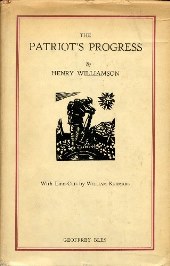 |
|
|
First trade edition, Geoffrey Bles, 1930 |
John Bullock enlists, endures the war, is wounded and returns home, back where he started.
The Patriot’s Progress is an account of an ordinary soldier’s experience in the First World War. Private John Bullock represents ‘Every Soldier’ or ‘Any Soldier’, and it must be noted that it is no coincidence that the title echoes John Bunyan’s Pilgrim’s Progress (1684). Bunyan in his turn had drawn on the medieval morality play Everyman, which tells the progress of its hero from complacency through fear and despair at the prospect of death to a resignation that leads to redemption. So it can be seen that some analogy can be drawn with these books. But HW does not follow the path of onward progress that Bunyan’s pilgrim Christian took. For HW’s central character ‘progress’ is an ironic allusion: there is no progress.
John Bullock (the name is allusive – ‘John Bull’ being symbolic for quintessential rural Englishman) is an ordinary man who at the onset of war becomes the archetypal common soldier fighting patriotically for a cause he does not understand; unthinking, unimaginative, but grimly determined, facing every horror, first of brutal initiation into army life and then that of the trenches with the futility of battle, until the inevitable result of a shell wound, leg amputation, and a return to the mindless non-understanding of life in England.
HW’s tight control of his subject matter in this book, his use of structure and language, show a compelling mastery of writing skill.
*************************
There is nothing in HW’s diary or personal papers to indicate any work in progress for this book other than a brief note at the beginning of March 1929 stating:
Work in hand during March
1. Patriot’s Progress
2. Village Book
3. Preface to Gamekeeper at Home [Richard Jefferies]
4. Read Jefferies & prepare Introduction to his selected essays.
Information has to be gleaned from letters in the business files and from HW’s own Preface to the 1968 Macdonald edition where he states:
The idea of The Patriot’s Progress grew from a suggestion, in 1928, that I should write captions for a set of lino-cuts which illustrated the Great War. The idea came from J.C. Squire, then editing The London Mercury from a small office in Fleet Street. “They are done by an Australian soldier who served, like yourself, on the Western Front,” said Jack Squire. “If you’d like to talk to him about it, we’ll go into the pub next door.”
J. C. Squire – John (‘Jack’) Squire (1884-1958, knighted 1933) – eminent critic, literary figure and editor of the London Mercury, had been on the committee that had awarded the Hawthornden Prize to Tarka the Otter in June 1928 and was very supportive of our author. The Hawthornden had thrown HW into prominence. That autumn saw the tenth anniversary of the Armistice of 11.11.1918 and HW had, as has been shown previously, published numerous articles about the First World War (culminating in The Wet Flanders Plain, published in June 1929). One of the main articles, around HW’s attendance at the Cenotaph Ceremony that year, was commissioned and published by the Daily Mirror: ‘Ten Years’ Remembrance’ (12 November 1928: reprinted in facsimile HWSJ 18, September 1988, pp. 28-9); while ‘Armistice Day 1928: What We Should Remember and What Forget’ was printed in the Radio Times on Armistice Day 1928 (reprinted in HWSJ 27, March 1993, pp. 40-1).
I think it can be assumed that it was while HW was in London attending this event that the conversation with Jack Squire and William Kermode took place.
William (‘Bill’) Archer Kermode (1895-1959) was born (in the same year as HW) in Tasmania, and was very proud of this background (stating that his forebears had helped establish Tasmania). He came to London in 1911, aged 16, living in Kensington, and volunteered as a Private in the Royal Engineers at or soon after the outbreak of the war. By 15 July 1917 he was acting second lieutenant in the Tanks Corps, and by September that year was engineering workshop officer in B Company 13th Tank Battalion. Involved in the Battle of Amiens which began on 8 August 1918, where there was a huge loss of the vital tanks, Kermode was awarded the MC,
for conspicuous bravery and devotion to duty near Hallu, east of Amiens, on 10 August, 1918.
Hearing that a tank had broken down, he had gone forward and despite heavy shelling and machine-gun fire, had repaired it fit for action, so that it could proceed. He continued to another tank, again repairing it so it could operate. Two weeks later, on 23 August, he was gassed (the Germans sent over gas shells at dawn into the woods where tanks were known to be assembled ready for attack) and was returned to England. It is not known what he did immediately after the war, but he had the usual small army pension and lived at ‘Tasma’ in Kew Gardens – where he is known to have grown eucalyptus plants on his windowsill!
In the mid-twenties (thought to be 1925-28) Kermode attended the Grosvenor School of Art run by the well-known wood-engraver Iain MacNab, where another teacher was the outstanding lino-cut artist Claude Flight. Kermode is known to have exhibited work in (early?) 1929, and was involved in posters and similar work (as was Charles Tunnicliffe) and, apart from HW’s book, is particularly known for his illustrations for The Specialist (Putnam, February 1930), a small slim volume (4 x 6½”, 30 pages) telling the tale of Lem Putt, privy builder extraordinary, written by Charles Sale, an American ‘vaudeville’ artist, who wrote down and published this wonderful monologue, used in his act, to protect his copyright. (The involvement of Putnam in such a book seems peculiarly odd but no details seem available!) (Personal information is courtesy of his godson in letter to AW.)
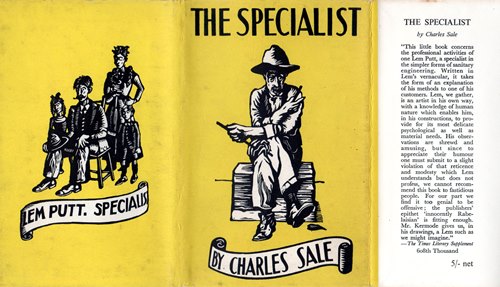
It is obvious that Kermode had examples of his work with him at that first meeting. It is also obvious that they actually struck a deep chord in HW’s psyche, although he never said so. In his 1968 Preface HW tells us:
The lino-cuts were almost caricatures, yet the details were real. I wanted the reality itself; and after several meetings with the artist, William Kermode, a quickly perceptive chap, the proposal was made that, if he could see his way to scrapping some of the scenes and cutting new pictures, I’d write an entire story around them . . . His lino-cuts would be shuttering to my verbal concrete. [This a reference to the structure of the German Hindenburg Line.]
And indeed HW’s compact, highly expressive language does exactly that, binding the illustrations, and vice-versa, with both making a perfect whole.
HW also states here that he had begun work on the book when he was sent a proof copy of All Quiet on the Western Front by Erich Maria Remarque (Putnam, 1929). The book had great acclaim, but HW felt instinctively that there was something false about it (as indeed later proved to be true), and that if this work was thought to be superb then there was no room for his own writing on the war – this thought put him off writing his book for a whole year.
That may indeed have been the case; but 1929 was quite a busy year for HW: he had fallen in love with a German girl, Barbara Krebs, who stayed at a boarding house in Georgeham, and was studying literature in London. He spent considerable time and energy in pursuit of this ‘Blakeian figure of joy’ until she returned to Germany at the beginning of 1930.
In January 1929 HW’s essay ‘Reality in War Literature’ (which discussed books which had appeared to date) appeared in the London Mercury, which was editied by Jack Squire. (The essay later appeared in revised form in The Linhay on the Downs and Other Adventures (Cape, 1934) and is discussed at that point.)He was also dealing with those 1929 limited edition volumes already covered in this series, revising the early Flax of Dream volumes, preparing his Jefferies work (though not published until later), and was also already working on what was to be The Village Book (1930).
On Friday, 12 July he attended the Hawthornden Prize ceremony, it being presented that year to Siegfried Sassoon for Memoirs of a Fox-Hunting Man: he noted ‘Author not present’, but scribbled copious notes about the ceremony, and who said and did what, in his diary.
Also he had bought the Field at Ox’s Cross, and was very busy building banks around its perimeter, planting trees, and designing and building his Writing Hut. On 28 July the long-planned visit from T. E. Lawrence took place: a simple luncheon at Vale House. Then in the autumn HW moved from Georgeham (Vale House in its turn now proving too small – a third child was on the way) about 20 miles west to Shallowford, a cottage on the estate of Lord Fortescue (older brother of Sir John who had written the Introduction for Tarka the Otter) at Castle Hill, Filleigh, near South Molton.
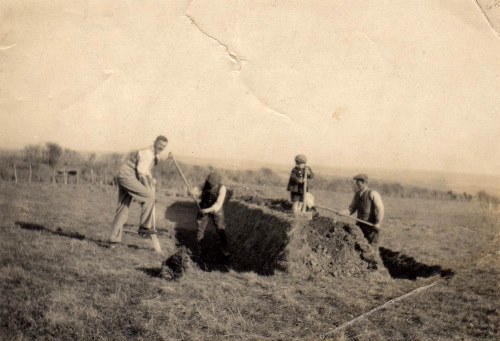
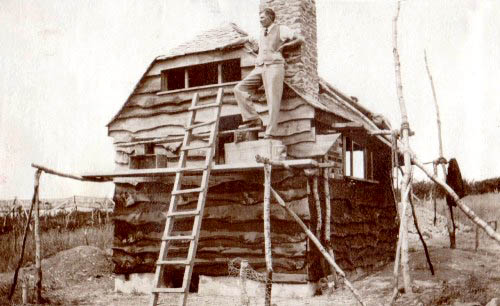
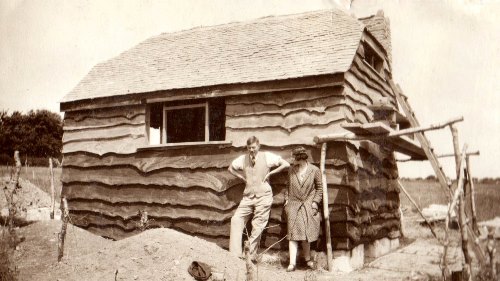 |
| Taking a break – HW and Barbara Krebs |
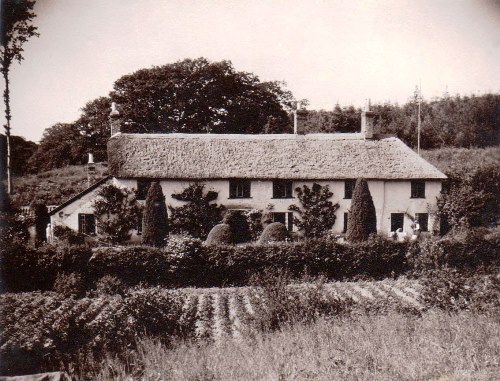
This involved constant visits and work from June 1929 onwards, the move being at Michaelmas. He was also sailing in the estuary in his little sailing dinghy Pinta,while Whitsun saw the perpetration of the ‘Georgeham Village Sign’ prank by HW with his new friends John Heygate and Bobby Roberts, which incensed the local worthies and ended in public apology! (See AW, Henry Williamson: Tarka and the Last Romantic and Lois Lamplugh's 'The Georgeham Village Sign Incident', HWSJ 29, March 1994, pp. 44-7 for further details.)
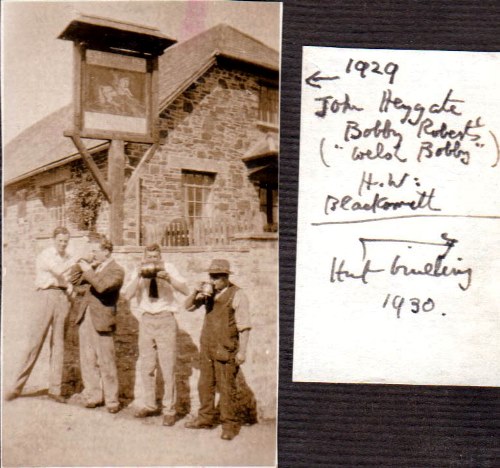
The first letter from William Kermode in the files is dated 19 February 1929: ‘Dear Williamson, We’re off - . . .’, saying that he will hand over a complete set of illustration proofs by end of April which will give HW the month he has said he needs for the writing, as Bles ‘would like the whole caboodle in his hands by end of May at latest.’
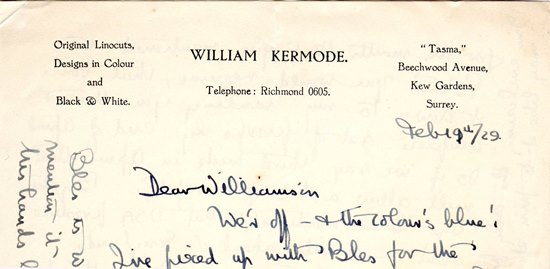
That the possibility of illustrations for a new edition of Tarka the Otter were being discussed is also mentioned, but needs further discussion when HW next in Town [i.e. London]. There is no further mention of this project whatsoever and no such edition ever appeared, although Kermode did design the cover for the 1929 Putnam edition.
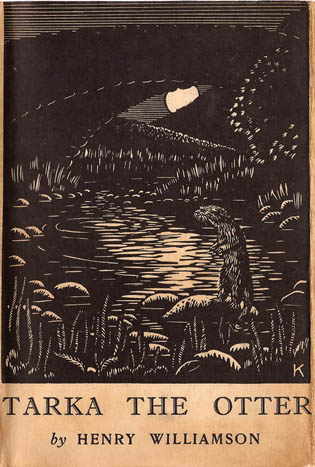
The impression one gets of Kermode from his letters is that he was confident about his own work, worth and expertise, although aware he was new to the book world and was very willing to be cooperative. His next letter, 21 February 1929, shows he was quite capable of standing up for himself:
You say it would be better if the prose didn’t describe the cuts, or the cuts the prose. . . . [I agreed] that text and cuts should augment one another. . . . Jack Squire’s studied opinion . . . [was] that the cuts only required a commentary to making them flow but now we’ve altered that & with Peters’s figure of 25000 [words] for text the whole thing will be a bigger & better undertaking altogether. But [in effect you need to work closely to cuts within a page, or my work will become secondary.]
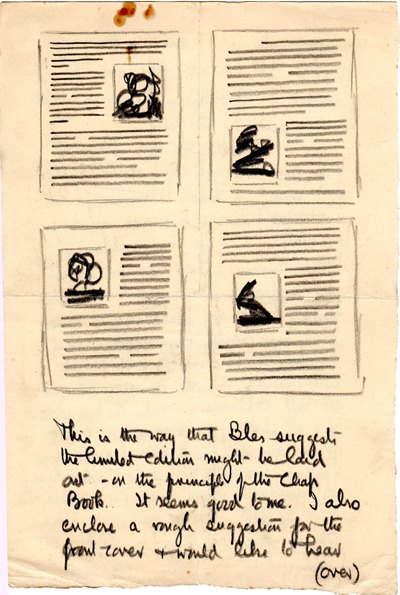
That he saw the work as equal is obvious throughout.
Kermode further reveals here that he has asked HW’s agent, Peters, to act for him also – something that HW would not have liked very much, as it would create a conflict of interests.
Kermode’s next letter (25 February 1929) shows he has arranged the quality etc. of the paper with Bles (an important item as regard to the best possible reproduction of the illustrations – the concern being that the very thick inking must not run) – an ivory (less stark than white) ‘Japanese mulberry’ (presumably paper made from that tree).
One can feel from WK’s letters (he invariably signed himself ‘WK’) that HW is getting tetchy from time to time. A letter from Geoffrey Bles to HW in early June shows that HW had now abandoned a large amount of text – obviously he had constructed his work without considering this parameter of close association to Kermode’s illustrations. He was not used to having to work to a set parameter, and certainly not one set by someone else. But WK’s letters are all cheery, occasionally conciliatory, but quite determined about his own role in the enterprise. That they had discussed an outline story-line at the earliest stage is obvious, and WK quickly produced ‘pulls’ accordingly. His letters show considerable adjustment of his work to HW’s request throughout the period of work – right up to the very end, when HW wanted adjustments when the book was in proof stage. Both wanted the very best for this book and were prepared to work hard for it.
As time went on there was some discussion about the division of royalties and fees that would occur from the various sources: USA, serial rights, future editions etc. HW had indicated that he should have the lion’s share. Peters, agent for both men and so rather a pig in the middle, set out a list covering the salient points: that WK’s cuts were the origin of the book, that the text and cuts were indivisible, forming one complete entity, although both parties could publish separately in the future. (Interestingly that has never happened: the two parts are so completely joined as one whole that no edition has (uniquely?) ever separated them.) After a while Peters called on Jack Squire to adjudicate on the matter, who said all divisions should be based on the proportions of the original Bles contracts – whatever they contained. This was to result in a seemingly absurd computation appearing in the accounts in due course: 31/91ths to WK – 60/91ths to HW. Peters remarked that this was more or less the same as the one third to two thirds they had started with – much ado about nothing! (Peters share as agent was 10% of HW’s earnings – and all his clients.)
It is extremely difficult to work out what royalties this book earned (the accounts are very obtuse! Titles often lumped together under the publisher’s name only), but two figures I have managed to pin down are: £420 from Bles in September 1930 (less £42 to Peters) – but there would have been an earlier advance payment of possibly £50; and also £150 from Dutton in August 1930 (less £15 to Peters).
On 13 January 1930 Geoffrey Bles wrote a handwritten personal letter (as opposed to typed and signed-only business letters):
My dear Henry Williamson,
I have just finished reading your “Patriot’s Progress” and I feel I must write straight away to tell you how much I admire it. I think the descriptions are magnificent – I have read nothing like them in any other war-book – and the underlying pathos is beautifully conveyed.
Many many thanks for giving me such a fine book.
Now we must go “all out” to make this a tremendous success. I am quite thrilled by it! . . .
There follows a few technical points, and Bles suggests it better not to include HW’s introductory ‘Note for Old Sweats’ as it is out of keeping with the text itself; he ends by again thanking HW for ‘this fine moving book’. (HW never proved very adept at writing introductions or explanations about his own work, always somehow managing to trip himself up.)
WK also wrote with his appreciation (16 January 1930):
Dear HW,
I was handed the text of the P.P. yesterday afternoon & read it right through in the evening. You have made a magnificent job of it in my humble opinion, its detail is extraordinary & its main note as true & clear as a bell. I should imagine that even you yourself feel satisfied with your work this time! . . .
A postcard from WK, postmarked 3 February 1930 states: ’I’m sorry you don’t care for the new title page cut’ (and continues with explanation as to why it was done).
HW kept this cut, although it was never published. No illustration appeared on the title page when published.
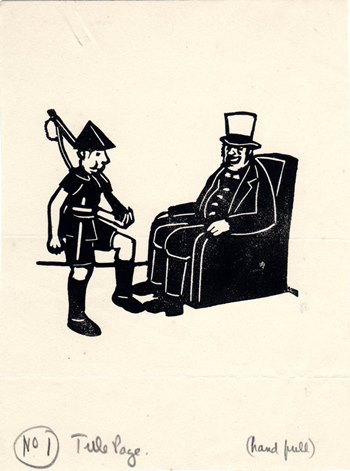
On publication HW found (to his great annoyance) that some expletives previously not commented on had been removed. WK wrote:
What is one to say about the deleting of words that someone or other does not like & the leaving in of words they apparently approve of & even the total elimination of shortened adjs [adjectives] . . . [he makes a list of joke comments here] . . . I really do understand something of the bitterness which enters into writers of the truth in these times.
The Patriot’s Progress was serialised in the Evening Standard from 8 to 28 November 1930, creating a huge amount of attention. While doing so the paper published this picture of William Kermode:

Despite the apparent camaraderie of these two men within this joint project, it is noticeable that there was no further correspondence between them after the book’s publication. After Kermode's death in 1959, aged 64, HW pasted The Times' obituary into his own copy of The Patriot's Progress, adding a further note:

*************************
So HW and WK produced between them this extraordinary book, wherein starkness of prose and illustration complement each other to record the harsh reality of the hell that was the First World War. A great strength of the book lies in its visual impact, particularly in the early edition, where the care taken over the design layout of illustration and text within generous margins combine to make a visual whole. Dr Leo John de Freitas, in The Art of the Illustrated Book (2003) considers it one of four great works of its type in the first half of the twentieth century.
Kermode’s lino-cuts portray the very essence of the horror of war. This is enhanced by the choice of a bold dark font (unusually not noted in the bibliographical details) and the fact that there are no paragraph divisions: the text runs on thick and black in a continuous monotonous flow, underpinning the effect of the book’s message. The tone is raw, insistent, relentless: very different from anything HW had written before – or since. It might almost be said to fit into ‘the stream of consciousness’ mode of writing.
John Onions (English Fiction and Drama of the Great War, 1918-39, Macmillan 1990) considers that HW’s Patriot's Progress, along with Aldington’s Death of a Hero, are the two most overtly bitter attacks to come out of the war book boom, stating that the usual attitude of such books was to portray the soldier as ‘social hero’. But these two are ‘ironic’. That is indeed the general acceptance, but ‘realism’ might be a better umbrella for HW to shelter under. In his 1968 Preface he states: ‘I wanted the reality itself.’
The DEDICATION, like the EPILOGUE, is pictorial only: one of Kermode’s lino-cuts depicting a cross constructed out of two bits of wood with a soldier’s war helmet balanced on top; lines depicting pouring rain slanting down relentlessly; with a (blank) profile of a man, indicating the spirit of the dead man leaving its lifeless body. It is an extremely powerful statement.
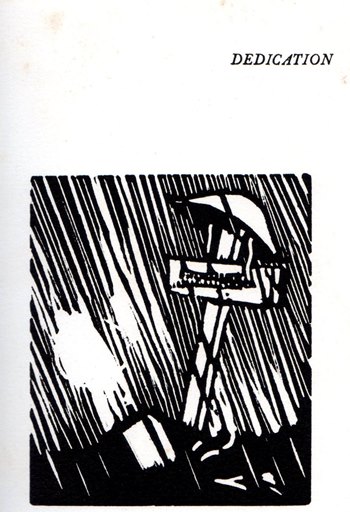
The book is divided into FIVE PHASES: they merely mark the inevitable progression of futility.
FIRST PHASE opens:
John Bullock, a youth beloved by his parents, was a clerk in the City of London. Both his father and mother came of farming stock . . . Every morning John Bullock went to London on a train. . . .
Those details are recognisable as deriving from HW’s own background, although John Bullock is not HW but the essence of ‘soldier’. The tone is deliberately impersonal and two-dimensional: but the reader is held in an immediacy of thought and action.
One of the first of WK’s cuts is of a young clerk sitting at a desk being overseen by a benevolent bearded Head Clerk, one hand encouragingly placed on the young man’s shoulder, the other harmlessly behind his back. This has significance when we come to the epilogue.
The holiday by the seaside that John Bullock is looking forward to is swallowed up by the declaration of war and he enlists at the Recruiting Office ‘for the Duration’. He bids his parents goodbye, opening the gate and walking up the hill. [Much as HW did; but apart from the occasional allusion, this is not the story of HW’s personal war, nor of Kermode’s, who took part in Third Ypres (Passchendaele): the subject is too universal.]
Training commences for ‘No. 19023 Private John Bullock’. That number had a peculiar significance. It is the number following that of the anonymous author ‘Private 19022’ (actually Frederic Manning) of Her Privates We (Peter Davies, 1930), previously published privately in 1929 as The Middle Parts of Fortune, a book HW considered ‘good’ in his essay ‘Reality in War Literature’, but in his Preface to the 1968 edition of The Patriot’s Progress upgraded it to ‘a masterpiece’. HW’s little ‘joke’ nearly rebounded on him as he stated in a letter (24 March 1930) to T. E. Lawrence that Geoffrey Bles thought he (HW) must therefore also be this anonymous author, and HW let him think that was so until he realised it was going too far and had to hurriedly retract!
When basic training was complete the men are sent off to ‘The Great Plain’ (Salisbury Plain) for more intensive training. We learn here that John Bullock was shy of using the open latrines, ‘Lats’ as they were known – a scene we find again in How Dear Is Life (Vol. 4, A Chronicle of Ancient Sunlight), when Phillip Maddison suffers the same inhibited anxiety.
The spring of 1915 arrives and the men remain camped on the Great Plain. Rumour of movement is constantly rife but ‘summer waned into autumn’. They learn of the fighting: Loos, ‘A Real British Victory at Last’; then 1916 – and the great ‘Somme Victories’. Finally they are granted four days Draft Leave (i.e. before going overseas), but by then they have begun to hear rumours about the awfulness of the Battle of the Somme. The First Phase ends: ‘Roll on, Duration.’
SECOND PHASE
The men pack up their equipment and prepare to go overseas. They embark and leave England behind; disembark, march to the Rest Camp and later entrain in the troop trucks marked ‘Homme 40 chevaux (en long) 8’. (These trucks were a notorious feature of troop transport.)
On and on puffed the train, halting and dragging on, halting and jolting forward . . .
Until eventually they hear a distant thunder in the air and realise it is gunfire. They are then marched forward:
‘Absolute silence.’ They walked on warily. A terrific blast of light, a terrific clapping shock, and a vast hissing diminishing overhead. . . . The power and terror of a gun firing had never been imagined.
They are taken down into a trench and put to work in support. After three days the company went into the front line. John Bullock gradually gets used to it all.
He smoked until his tongue was tired, but still it rained.
A sudden flurry of close gunfire is unnerving. Then they go out of line – and get a bath in a ‘brasserie’ (brewery) and chance to delouse: then it is pay parade and
with his chum, the red-faced youth called Ginger, John Bullock went to find an estaminet, marked up with the leaning irregular letters:

Three days in billets, three in reserve half-sheltered farms on day and night fatigues, three in support, three in the line. Raining, raining, raining, always bloody well raining.
Then they learn they are being relieved: ‘Roll on, Duration!’
THIRD PHASE
Marching forward:
Red and yellow were the woods they marched by, so peaceful and silent under the sun of the early morning. Their nailed boots bit the worn grey road. Sprawling midday rest in the fields above the sunken valley road, while red-tabbed officers in long shiny brown boots and spurs cantered past on the stubble, the larks rising before them. But the sunshine ceased, and it rained, and rained and rained. On the sixth day they rested . . .
The tone is a relentless driving forward, spiralling down in metaphorical circles ‘towards the unknown’. But note the nod to Tarka the Otter in the ‘red and yellow’ (autumn leaves floating down the river) and that biblical ‘on the sixth day’.
They arrive in Albert. Kermode has a stark cut of the familiar leaning ‘Golden Virgin’ on the church tower and an even starker ‘Bapaume road’ down which they travelled (a different softer one in the limited edition was one of those corrections not made at the proof stage that so annoyed HW).
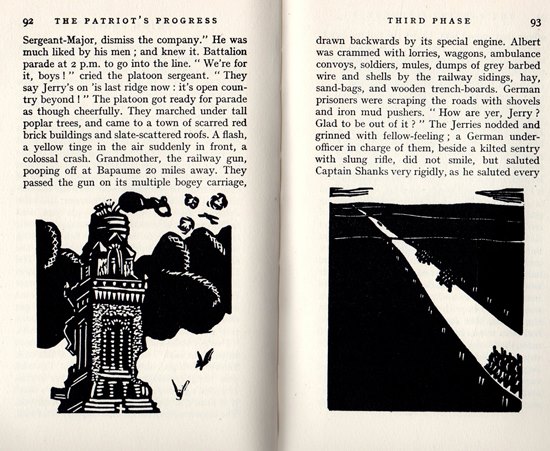
And so into the Front Line. The descriptions hold the reader in awful dread. As the section ends so John Bullock’s friend Ginger is shot and dies (as did HW’s friend Baldwin in real life – related in How Dear Is Life), falling back into the trench. They bury him in a shell-hole. ‘The cry was no longer Roll on, Duration.’
FOURTH PHASE
Back near Ypres ‘at rest’, the battalion trains for attack, while fatigue parties go forward daily through a landscape of living deadly hell. HW weaves into this dreadful tale here an overview of the progress of the war: May 1917, the attack on the Hindenburg Line – Whitesheet Hill, mines and Messines – Y/Z night.
He also includes a description of the ‘Étaples Mutiny’ of early 1917, an incident which was kept secret for fear of lowering morale and little known for many years. Indeed the book The Monocled Mutineer (1978), televised in 1986, was considered, to wild acclaim, to be the first to reveal this incident. With the serialisation of HW’s The Patriot’s Progress in the Evening Standard in the autumn of 1930 (see below) there was a flurry of letters on the subject from those who had been present and witnessed this event. HW further brought this incident into his later novel Love and the Loveless (Vol. 7, A Chronicle of Ancient Sunlight, Chapter 15, ‘Mutiny’) published in 1958 – still twenty years ahead of the supposed ‘amazing’ later revelation (see the letter from John Homan in HWSJ 16, Sept. 1987, pp. 37-8).
Then a bomb falls on the hut killing three men, wounding several others. With such a narrow escape, John Bullock’s thoughts sharpen. He thinks of the ‘red-lamp’ houses: he might as well join the queues of men ‘having a go’ before what seems inevitable death. He sings the soldier’s song about Von Kluck (see How Dear Is Life where a similar scene occurs). The rhyming word was cut out by the printer – one of those omissions that annoyed HW. But there were strict rules about the use of such profane expletives at that time – however true to life the situation.
Asking advice from, and accompanied by, his comrade Nobby Clark (another ‘universal’ name type), he drinks for Dutch courage, and eventually gets enough wine inside him to dare enter the ‘knocking shop’, and the scene is described in all its inglorious titivation. To shut his mind to the incident and the war that caused it, he drinks more thinking:
of the old days before the UTTERLY GONE FOR EVER.
Note the allusion there to HW’s poignant note that he appended to his school-boy pre-war ‘Nature Diary’. On return to camp John Bullock is arrested and given ‘Fourteen days’ field punishment No. 1.’ His thought now is: ‘Roll on, the attack!’
The Battalion parades, and is inspected by ‘The Butcher’ (already referred to as passing by in his car – this was the name given to Field Marshal General Sir Douglas Haig) and we meet the regimental chaplain ‘Cheero Boys’:
one of those rare men . . . who did all he could to help the men, whom he understood. And he went where they went.
Among the books that HW lent William Kermode was Benedict Williamson’s ‘Happy Days’ in France & Flanders (1921), the experiences of a padre with the 47th and 49th Divisions; WK asked: ‘Is the author of ‘Happy Days’ any relation of yours? – I wish I’d struck a Padre like him – my luck ran very much in the other direction.’ This suggests ‘Cheero Boys’ was based on this well-known figure: he was certainly an element of ‘Father Aloysius’ in the later Chronicle novels.
So the men move inexorably towards the Front – to the battle that was Third Ypres – taking that road from Poperinghe to Ypres that HW had traversed on his recent return visit (see The Wet Flanders Plain page) but here it is immediate and raw. We find John Bullock’s platoon officer is ‘Mr. Maddison, always a cheery word for them, a proper toff.’ I’m sure we all smile at that sly insertion! Is this Willie or Phillip? (the former the chief character of the Flax of Dream series: the latter from the Chronicle.) BUT –
O Why, Why, was the war? Death was darkness, good-bye forever. FOREVER. He couldn’t go over the top. No, no. Over the top was terrible. DEATH. He couldn’t.
They go forward through mud baths, shellfire and the ever-present rain – ‘battle weather’. His friend Nobby Clark falls and is gone. He becomes aware of cumbersome tanks also moving forward. A shell sets one on fire and all hell is let loose. It takes eleven hours of this for them to get into position. A short rest in the wet mud, then the order to go over the top is given. He gets across three hundred yards and then, a 'great lurid—'
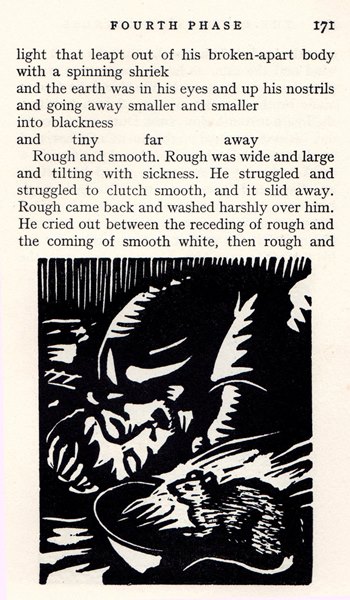
He lays there two days drifting in and out of consciousness (powerfully written, HW effectively using the word ‘rough’ as a metaphoric noun), until a stretcher party finds him and seeing a flicker of life in his eyes cart him back to the first aid post, where ‘Cheero Boys’ works tirelessly to comfort the men (and who ‘died of nervous exhaustion soon after the Armistice’). There is no more ‘Roll on, Duration’ in John Bullock’s spirit.
FIFTH PHASE
John Bullock’s leg is amputated at the Field Hospital, he is laid to one side; and later, as he is still alive, he is removed in an army ambulance. Meanwhile, back in England, an old man reads an account of the battle to his wife (‘Dad’ and ‘Mother’):
But the cry of ‘No surrender!’ was in the souls of these gallant men. They had no complaint against the fate that thrust them into the morass nor any whimper against their hard luck . . . [etc. in heroic vein] . . .
The wind against the window made a sudden high shriek like mad laughter.
In a letter to T. E. Lawrence (24 March 1930) HW noted:
The quotation at the end (old man reading from his Liberal paper) is Philip Gibbs verbatim. I expect to go to prison.
Philip Gibbs was an official, and very well-known, reporter during the First World War. His reports were unfailingly ‘optimistic’, painting a somewhat rosy view of the war situation: that no doubt was the official line he had to defer to – for the morale of the populace had to be maintained.
John Bullock is put onto a train back to No. 4 General Hospital and in due course back to England. His parents visit having no understanding of what the experience of war has been like. His father will not believe that he never saw a ‘Hun’. He screams at them and the nurse sends them away. Bewildered, they have no understanding.
Months and months of pain and contentment . . . the stump healed clean . . . he lost all interest in the war.
On the following 11th November he was out on the street:
In his suit of hospital blue, with trouser turned up . . . swinging himself along on his single leg between crutches . . . waiting for the maroons to go off at eleven o’clock.
In these closing paragraphs we are shown that the British public have no understanding of what the war has been like. An elderly well-to-do gentleman patronises him, offering a cigar and telling him England will look after the maimed. But John Bullock has the last word.
‘We are England,’ said John Bullock, with a slow smile. The old gentleman could not look him in the eyes; and the little boy ceased to wave his flag, and stared sorrowfully at the poor man.
EPILOGUE
There are no words: just a single illustration echoing that on p. 4: an older one-legged John Bullock seated at a desk overshadowed by a hard-looking Head Clerk – no longer with benevolent hand on his shoulder but with avaricious face and claw-like hand. He is back where he started. There has been no progress.
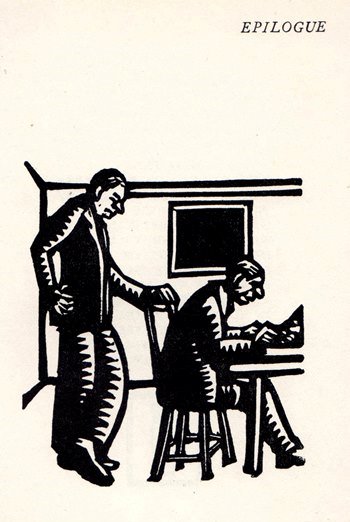
*************************
There have been several references to T. E. Lawrence (Lawrence of Arabia) within this text. HW and TEL had struck up a friendly correspondence since the publication of Tarka the Otter, and TEL had visited him at Georgeham in July 1929.
HW had obviously sent him a copy of The Patriot’s Progress – a typescript or early proof of the book, as mention of it pre-dates publication by two months. TEL’s letter about this book is dated 18-21 March 1930, and is a critique in much the same vein as the one he wrote about Tarka.It is printed in the 1968 edition of The Patriot’s Progress but a few points are useful to mention here.
. . . It is all right: that is the first thing to say. . . . [it] survives as a thing of its own. . . . This book is a tapestry, a decoration: the almost-null JB set against a marvellous background. It is the most completely two-dimensional thing possible [that is meant as a compliment] . . . You seem to be able to pen a good phrase in simple words almost as and when you please. You beat Bunyan there, for he got to the end of his P.P. without throwing in a deliberately fine phrase. I noted with pleasure [there follows a long list of particular words and phrases he liked] . . . I have enjoyed the P.P. very much. The Hut fellows [at that time Lawrence was stationed at Plymouth] say that it isn’t properly named, it not being a ‘bloody bind’ like that Bunyan chap’s stuff.
(The letter is also printed in T. E. Lawrence Correspondence with Henry Williamson, (T. E. Lawrence Letters, Volume IX), ed. Peter Wilson (son of Jeremy Wilson, T. E. Lawrence biographer) with commentary by Anne Williamson and excerpts from HW’s Genius of Friendship, Castle Hill Press, limited ed., 2000.)
*************************
